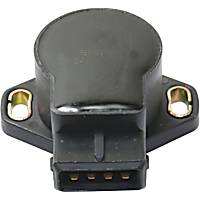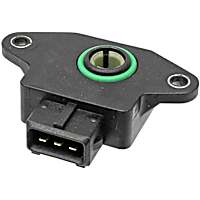When the Check Engine Light on your car’s dashboard lights up, it’s time to use a diagnostic scanner to determine what faults triggered the CEL. Typically, there are a variety of diagnostic trouble codes that could potentially be the culprit—and one of them is the P0122 code.
What Does the P0122 Code Mean?
Diagnostic Trouble Code (DTC) P0122 stands for “Throttle Position Sensor/Switch A Circuit Low Input.” The powertrain control module (PCM) logs a P0122 code when the throttle position sensor “A” displays lower voltage than normal.
As its name implies, the throttle position sensor keeps track of the throttle’s position. It is usually located on the throttle body, but this fault can also indicate a problem with the electronic throttle pedal on newer vehicles.
The signal from the throttle position sensor guides the computer in managing the ratio of air to fuel and the best time to trigger the spark plugs. The data also helps manage other parts of the emission system.
For an advanced, technical description of different configurations of throttle position sensors, read our discussion here.
To learn the possible causes of code P0122, read the next section.
What are the Possible Causes of the P0122 Code?

The voltage of the throttle position sensor can drop below the expected range for several reasons, including the following:
- A loosely-mounted throttle position sensor
- Electrical short on the sensor circuit, either to the ground or to another wire
- Faulty sensor
- Faulty throttle position switch
- Bad or corroded wiring or connections for the sensor
- Issues with the PCM
What are the Common Symptoms of the P0122 Code?
As with any engine-related trouble code, the P0122 code will activate the Check Engine Light.
Other symptoms include:
- Hard starting engine
- Engine hesitates while accelerating
- Rough, low, or very high idle
- Engine stalling
- Surging
- Minimal or zero acceleration
How to Diagnose the P0122 Code
Figuring out exactly what triggered the P0122 code can be tricky. You can leave the job to your mechanic or you can try to do it yourself with the help of a detailed guide.
You can check out the video below to help you understand how to diagnose the code properly:
How to Fix the P0122 Code
The sheer number of possible causes that could trigger the P0122 code means there’s no single way to fix it. Most people leave the job to their mechanics, but you can fix it yourself if you’re confident enough in your automotive DIY skills.
If you’re a beginner, make sure to do your research—and there are plenty of online auto repair resources and guides to help you do that. We also suggest getting an ALLDATA single-vehicle subscription (which would be specific to your vehicle) for this and all future repairs your car may need. Also, do consult your owner’s manual before you begin working on your car.
As mentioned, you won’t find a definitive fix for any code. You’ll have to figure out the underlying cause, then do your research on what fixes have worked to clear the code. Keep in mind that some fixes may only work for certain makes and models, and not for others.
For example, replacing the PCM or VCM and repairing the throttle position sensor are some of the fixes that have been confirmed to work for various model-years of the Chevrolet Blazer. However, they may not work for other vehicles that are displaying the P0122 code.
Other Notes About P0122
Several OBD-II trouble codes also cover the performance of the throttle position sensor at the “A” position. They are:
- P0120: Throttle Position Sensor/Switch A Circuit Malfunction – the voltage goes higher or lower than normal, or stutters in comparison to the “B” sensor
- P0121: Throttle Position Sensor/Switch A Circuit Range/Performance Problem – the throttle angle doesn’t match the value expected for a specific RPM
- P0123: Throttle Position Sensor/Switch A Circuit High Input – the voltage exceeds normal values
- P0124: Throttle Pedal Position Sensor/Switch (TPS) A Circuit Intermittent – the sensor sends a number of intermittent or erratic signals within a set period
A Closer Look at Throttle Position Sensors
Throttle position sensors on older cars with cable-operated throttles are a single analog (not digital) unit mounted on the throttle plate shaft to provide throttle angle position to the ECM/PCM. Vehicles with an ECM (which controls only the engine) and TCM (which controls the transmission) rather than a PCM (which controls both engine and transmission) will usually (not always) have two TP sensors, one for the transmission control module and the other for the engine control module.
Early Asian and European vehicles sometimes have an analog TP sensor that includes an idle tracking switch (digital input) that closes or opens when the throttle is released to track when the vehicle should be idling. The ECM/PCM can use the idle tracking switch compared to TP sensor voltage to determine if there is an issue with the sensor – if the idle tracking switch indicates idle but the TP analog portion of the sensor indicates otherwise, a code is set.
This potentiometer type analog sensor has a moveable contact connected to the throttle valve that slides on a resistive strip, and the closer the slider moves toward the wide open throttle, the nearer it is to the 5-volt end of the strip, the higher the voltage. Likewise, the lower the slider moves toward the signal return end of the strip, the lower the voltage. Voltage at idle is typically from .5 to 1 volt and at wide open throttle it will be 4.5-4.7 volts. This varies slightly between manufacturers.
With the advent of Electronic Throttle Control, which some will call “drive by wire,” putting the ECM/PCM in charge of throttle angle made it expedient to have redundant TP sensors; more than one sensor in each spot – usually with two or three TP sensors on the Accelerator Pedal assembly (called AP sensors) and two or three TP sensors on the throttle body.

Most throttle position sensors are potentiometers – a three- sensor with a reference voltage (5 volts), a signal return (ECM/PCMground), and a TP signal wire between those voltage and ground feeds that changes voltage with throttle position. On systems with redundant TP sensors, the two or three sensors don’t all produce the same voltage at the same time – some have the sensor voltages “mirrored,” if you watch them on a scope.
Other systems have the sensors reading various different voltages that are expected to follow certain parameters. Some sensors in a redundant array might top out at .75 volts while other sensors might top out at over 4 volts, with a third sensor topping out at 2.5 volts.


How to Get a Quality Replacement Throttle Position Sensor to Fix the P0122 Code
A bad throttle position sensor can trigger diagnostic trouble codes like the P0122 code. If ignored, the bad sensor causes issues like idle surges, stalling, and hesitation while accelerating. Before the situation gets worse, order a quality replacement throttle position sensor here at CarParts.com.
There’s no need to step out of the comfort of your home and wait in a long line to get a new throttle position sensor. Simply plug your vehicle’s year, make, and model in our website’s built-in vehicle selector to bring up quality products from brands trusted by drivers across the country. CarParts.com adds to the convenience by stocking its parts in strategically positioned warehouses, so you don’t have to wait long before your order arrives.
Don’t wait to replace a faulty throttle position sensor! Check out our wide selection of throttle position sensors and enjoy low prices on quality products!
Products Mentioned in this Guide
Any information provided on this Website is for informational purposes only and is not intended to replace consultation with a professional mechanic. The accuracy and timeliness of the information may change from the time of publication.


 Throttle Position Sensor
Throttle Position Sensor
 Throttle Switch
Throttle Switch















I got code p0122 then p0123 than p0456 p1648 than it said done. 2001 dodge Caravan sport
No acelera chevi avalanche 2008